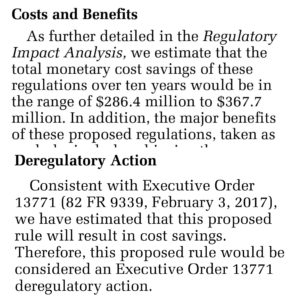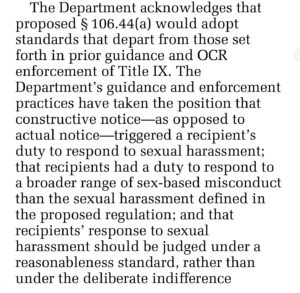
U.S. Secretary of Education Betsy DeVos is proposing an unprecedented roll-back of Title IX guidelines that have helped to create the framework American schools have used to combat sex-based harms for over 20 years. The Title IX Notice of Proposed Rulemaking (NPRM), which was formally published last Thursday, would do far more than provide procedural safeguards for respondents as part of a much larger administration de-regulatory agenda.
If enacted the proposal would fundamentally alter how Title IX works. Of particular note it would create a substantially different process for sex-discrimination than those required to be used for other civil-rights protections like race and national origin which haven’t been the subject of this type of rulemaking process as we’ve previously written about.
While much work remains to be done, higher education has made significant progress in how it handles sex-based harms in campus communities over the last 27 years. Along with the Clery Act’s “Campus Sexual Assault Victims’ Bill of Rights” (now the Campus SaVE Act), Title IX has provided an essential framework for this progress especially since the Obama administration reminded schools of it through the widely known 2011 “Dear Colleague Letter” which was withdrawn in 2017.
Since formal guidance was first issued in 1997, and at least as early as 1994, the U.S. Department of Education’s Office for Civil Rights (OCR) administratively investigated reports that sex-based harms weren’t properly dealt with using standards lower than those required to prevail in a Title IX court case. This is because for the most part money damages aren’t at issue instead improved policies and procedures are. The Title IX NPRM would abandon these long used administrative standards and instead more closely align with stricter rules used in court cases narrowing the field of cases subject to Title IX protections significantly.
Formal Report Required
The standard used by OCR has been when “a school that knows, or reasonably should know, about possible harassment” which includes sexual assault they “must promptly investigate to determine what occurred and then take appropriate steps to resolve the situation.” The Title IX NPRM would not only require actual knowledge, but a formal written and signed report made to an authority with the power to remedy the situation. Under the Title IX NPRM a school that knew or should have known about a hostile environment would be under no obligation to act absent a signed written complaint.
While the stated purpose is to align more closely with Supreme Court precedent, specifically Gebser v. Lago Vista Independent School District, 524 US 274 (1998), “actual notice” is not defined in that decision to include a written and signed complaint. Also, significantly in Gebser, the Court was addressing money damages, not remedial action.
Deliberate Indifference Standard
In assessing an institution’s response OCR currently uses a “reasonableness” standard to assess “schools’ responsibility to take immediate and effective steps to end sexual harassment and sexual violence.” The Title IX NPRM would adopt a “deliberate indifference” standard currently used in cases only where money damages are at issue. This means that the response, or lack thereof, is “clearly unreasonable in light of the known circumstances.” In practice this applies only to the most egregious cases, such as taking no steps whatsoever to respond.
Narrower Definition
In OCR’s administrative enforcement cases “Sexual harassment is unwelcome conduct of a sexual nature…Sexual violence is a form of sexual harassment prohibited by Title IX.” Title IX is invoked when “the conduct is sufficiently serious that it interferes with or limits a student’s ability to participate in or benefit from the school’s program.”
Adopting a narrower standard the Title IX NPRM would define “sexual harassment” in this context as “Unwelcome conduct on the basis of sex that is so severe, pervasive, and objectively offensive that it effectively denies a person equal access to the recipient’s education program or activity; or… Sexual assault”. While based on a Supreme Court opinion, this standard is actually even more limited because the Court held, in Davis v. Monroe County Board of Education, 526 US 629 (1999), that institutions may be liable when the conduct is “so severe, pervasive, and objectively offensive that it can be said to deprive the victims of access to the educational opportunities or benefits provided by the school.”
The Title IX NPRM would require actual deprivation of access to the educational program or activity itself not merely the opportunities or benefits provided by it, a standard that need not even be met in a case for money damages. The Court interpretation is broader and includes deprivation of “educational opportunities or benefits” not the whole program. Harms short of driving a victim of discrimination out of school, such as forcing them out of a class or housing, which are common challenges may no longer trigger an obligation to respond. This conflict with precedent could also expose schools to civil liability if they meet the regulatory standard but not the one set by the Court.
Explanation of Changes

The DeVos proposal explains these changes saying “Based on its consideration of the text and purpose of Title IX, of the reasoning underlying the Court’s decisions in Gebser and Davis, and of the views of the stakeholders it has consulted, the Department now believes that the earlier guidance should be reconsidered.” There is no substantive analysis of any supposed problems with an approach that has been in place for over 21 years, and unlike the “due process” issues discussed for over a year there was no comparable public discussion of these matters in advance.
This proposal is far from taking effect, but the changes could be significant. The final regulations, which will be published sometime after the public comment period ends on January 28, 2019, may differ and any final rule is likely to be challenged in court.
Conclusion
These steps to narrow the scope of Title IX’s protections are counter to over 21 years of progress towards combatting sex-based harms across educational programs in the United States. They aren’t in any way necessary to address concerns about procedural safeguards afforded to any party in disciplinary proceedings, and only serve to allow the Department to contend the new regulations are a cost saving measure while enacting extensive new regulations that would otherwise be prohibited under the current administration’s de-regulatory rules.
Even the Title IX NPRM itself, however, acknowledges that many institutions of higher education (IHEs) won’t actually reverse course in these areas as they are optional as opposed to the mandated “due process” guidelines. “Among IHEs, we assume that, for a large subset of recipients, various pressures will result in retention of the status quo in every manner that is permitted under the proposed regulations,” it states. “These institutions are voluntarily assuming higher costs than the regulations require.”
At SAFE Campuses, LLC our team has over 100 years of combined experience combatting sex-based harms in education, and we stand with those institutions and colleagues at educational institutions who won’t back away from working to effectively prevent and respond to sex-based harms. Students at institutions that don’t hold this ground, however, shouldn’t be afforded less protections. Because the Title IX NPRM would irresponsibly reverse more than 21 years of progress in combatting sex-based harms we oppose it.
